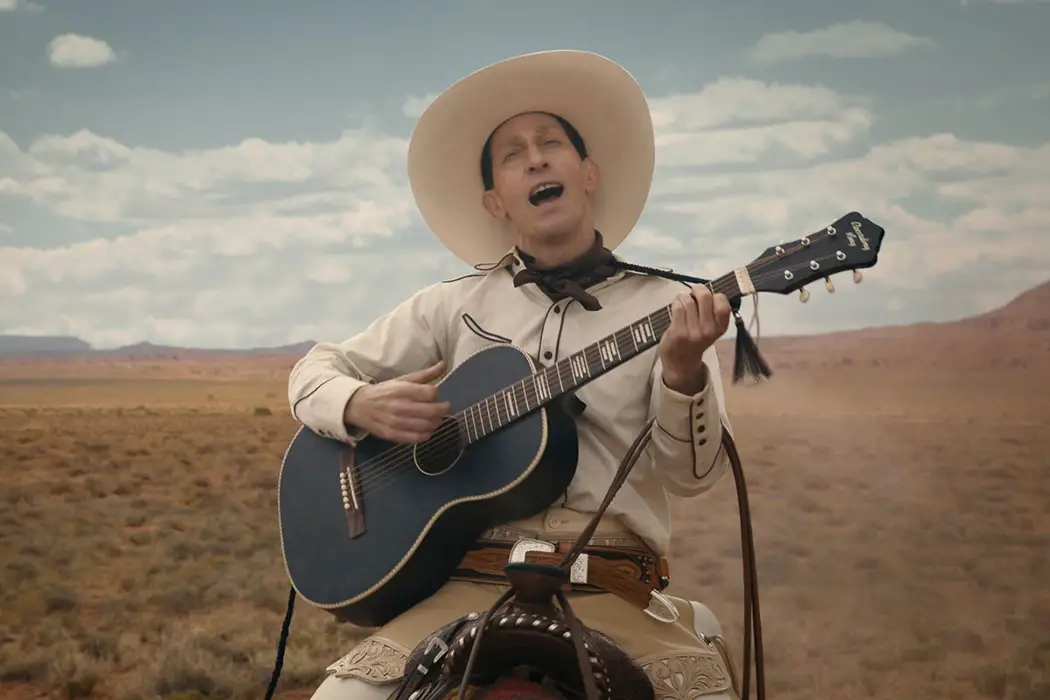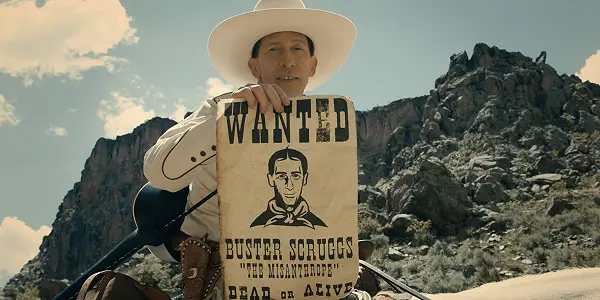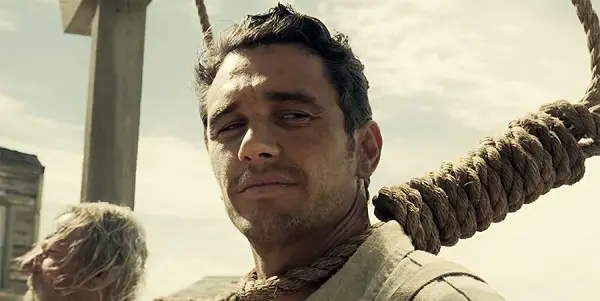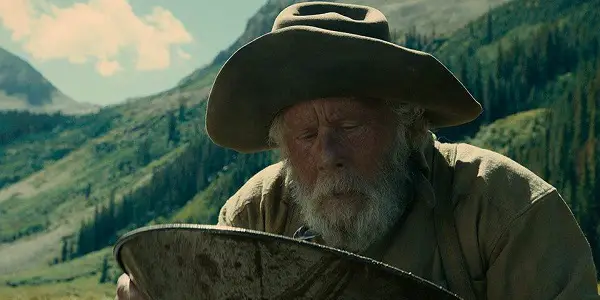THE BALLAD OF BUSTER SCRUGGS: An Absurdist Delight

Seattle area film critic and aspiring screenwriter. My reviews can…
For the first hour of Joel and Ethan Coen’s homage to the American Western, The Ballad of Buster Scruggs, I was plagued by an eerie feeling that I had seen it before. It wasn’t until an ancillary character casually refers to “Miss Flannery” that it finally clicked why this film seemed so stylistically familiar. In every wonderful way, The Ballad of Buster Scruggs feels like a visual collection of Flannery O’Connor short stories.
Known for her sardonic and unsympathetic approach to human frailty, O’Connor had the ability to embrace the grotesqueries of our often skewed morality. The Coen Brothers share the same delicious gift for storytelling, interlocking damnation and grace into tightly bound emotional allegories.
The Ballad of Buster Scruggs weaves together six stories, each playing fast and loose with popular conventions of the genre, into an absurdist delight. Cowboys sing, bullets fly, and over-matched characters struggle to impose their will on an indifferent Frontier in this brilliant, low-key affair that feels, tragically, doomed to be overlooked in the Coen oeuvre.
Starting Light…
The Coens make no attempt to hide their literary inspirations, using an old book (which boasts “color plates”) as their framing device to interweave six stories that seemingly have nothing in common. The only character shared between the stories is the rugged Western Frontier, which remains our unyielding companion throughout. Thanks to cinematographer Bruno Delbonnel, we see every color of this shifting landscape, from the golden hues of fertile river basins to the desolate scrub brush of the open Plains to the snowy grey wisps of the Oregon foothills.

It’s only when taken as a whole that the presentation of these short stories makes sense. Each chapter provides a specific cadence and mood that both cleanses the palate and adds a new element of Western lore. All other connections are artificial; desperate attempts by the viewer to fashion a more cinematic narrative out of this decidedly literary framework.
Each story plays with popular Western themes, distilled down to their essence and then reconstituted with Coen-esque characters and absurdist visual compositions. The opening story, “The Ballad of Buster Scruggs,” introduces Tim Blake Nelson (“Buster Scruggs”) as the Gene Autry ‘singing cowboy’ character. He strums and shoots his way from one desolate outpost to the next, leaving a trail of catchy tunes and dead bodies in his wake. Buster is the nicest, most cordial psychopathic gunslinger you ever did meet, and his segment is the perfect introduction to the mixture of whimsy, bloodshed, and moral turpitude that’s to come.
Next, James Franco stars as a laconic bank robber in “Near Algodones,” which will likely be regarded as the weakest of the six segments. While slight in its aspirations, it also features the best example of what makes The Ballad of Buster Scruggs shine; ruthlessly efficient storytelling. The Coens (who also wrote the script) establish the premise and characters with a modicum of dialogue. Who needs chitchat when a howling desert wind and squeaky chain can set the mood?
They also make great use of some fiendishly wacky visuals, such as a twitchy bank teller armored in pots and pans (Stephen Root creating the new catchphrase “Pan shot!”). Time and time again, the Coens find the best way to illustrate just how quickly your fate can change in the Old West. They also create one of the most intense (yet farcical) hangings in history, balancing James Franco, a noose around his neck, atop a horse whose casual grazing pulls him further and further away from the hanging tree. The tightening rope between the tree and Franco’s neck creates a striking geometric angle that must have delighted the meticulous filmmakers.
The Darkness Abides…
The third and sixth segments feature the Coen Brothers at their darkest. “Meal Ticket” tells the story of an armless and legless “Thespian, Orator, and Popular Entertainer” known as “The Wingless Thrush” (Harry Melling). From the back of a rickety wagon, he sits in a wooden chair and performs orations to tiny crowds of mildly amused Frontiersmen. His caretaker is a rotten-toothed Impresario (Liam Neeson), who occasionally uses their earnings to secure female companionship. He’s nice enough to strap The Wingless Thrush to a chair and take him along.

Melling’s commanding stage performances, which feature recitations as diverse as Shelley’s “Ozymandias” to Lincoln’s “Gettysburg Address,” are hauntingly juxtaposed with his wordless offstage existence. Using only his eyes, Melling conveys the dreariness of this existence and the inevitability of his character’s demise. It’s grim stuff, played without judgement or sentiment by the Coens in perhaps their bleakest work to date.
The film’s most divisive segment is likely to be the concluding, “The Mortal Remains.” Unlike previous segments, the Coens luxuriate in dialogue here, trapping five characters in a claustrophobic stagecoach carriage. Each character, through either speech or song, shares their personal philosophy on life, love, and the inevitability of death. To the simple fur trapper (Chelcie Ross), “People are like ferrets,” while the cultured Frenchman (Saul Rubinek) offers that in the game of life, “We must each play our own hand.”
As the carriage rattles on and the color tinting grows bluer, we come to question where exactly the Coen Brothers have taken us. Even the storefronts in this town are actual store fronts, with no buildings behind them. It is an artifice; a hodgepodge of clichés and half-remembered legends designed to create the illusion of civilization. It’s the final stop, not only for The Ballad of Buster Scruggs, but for all of us.
The Creamy Center…
Nestled in the middle are the film’s most unhurried segments. By this time, we understand the Coens are creating more of an experience than a unified statement. We are welcome to engage each piece on its own terms. Some of these stories, such as “All Gold Canyon,” would falter beneath the weight of an expanded treatment, while others, like “The Gal Who Got Rattled,” leave you craving more.
Tom Waits is our sole companion for “All Gold Canyon.” This ancient prospector, we suspect, has been alone for a long time. He methodically digs holes and sifts, trying to find the elusive pocket of gold that will deliver on the dream of Manifest Destiny. He’s also the kind of man who can compromise with nature, even bargaining with an owl about how many eggs he will steal from its nest. He’s perhaps the saddest, most lonesome character and yet he enjoys the most sustainable approach to the Frontier; he takes what the land offers him and then he leaves.

“The Gal Who Got Rattled” follows and it’s straight out of O’Connor. This is the emotional bombshell in The Ballad of Buster Scruggs and serves as the film’s de facto conclusion (with “The Mortal Remains” acting as an epilogue of sorts). Alice (Zoe Kazan) and her weaselly brother (Jefferson Mays) are headed to Oregon in a wagon train. Along the way, Alice takes a shine to the kindly horseman Billy Knapp (Bill Heck), and the two set about planning a future together.
Their story unfolds at a leisurely pace, inviting us to invest in a future we know is tenuous at best. Alice and Billy are the most relatable (and arguably the most contemporary) characters you’re likely to encounter in this savage world, and your heart yearns for the Old West to humor their unjustified optimism. This is the closest the Coens have come to recreating the unbearable tension that punctuates their masterful revisionist Western, No Country for Old Men. After the events have unraveled and your nerves have calmed, you realize that The Ballad of Buster Scruggs is a minor masterpiece in its own right.
The Ballad of Buster Scruggs: Conclusion
The success or failure of The Ballad of Buster Scruggs won’t be decided on ‘the big screen,’ but on television screens. The streaming powerhouse Netflix bankrolled the film and constitutes the only opportunity that most people will have to see it. I do hope audiences find this unassuming gem. The storytelling is so delicate and precise, like a beautiful poem squeezed of every superfluous word. This is some of the Coen Brothers best work and it deserves to be seen.
Does The Ballad of Buster Scruggs have a better chance of being discovered in theaters or on Netflix? Share your thoughts in the comments below.
The Ballad of Buster Scruggs is now available on Netflix.
Does content like this matter to you?
Become a Member and support film journalism. Unlock access to all of Film Inquiry`s great articles. Join a community of like-minded readers who are passionate about cinema - get access to our private members Network, give back to independent filmmakers, and more.
Seattle area film critic and aspiring screenwriter. My reviews can be found in The Seattle Times, PopMatters, Nonfics, Goomba Stomp, and Sound on Sight, just to name a few. Post-rock is kind of my obsession, so I'm probably listening to it right now...













